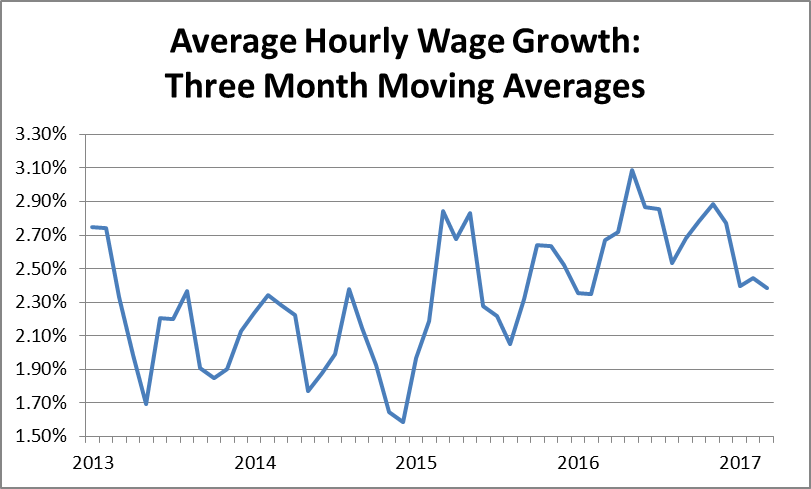Article • Dean Baker’s Beat the Press
Fact-based, data-driven research and analysis to advance democratic debate on vital issues shaping people’s lives.
Center for Economic and Policy Research
1611 Connecticut Ave. NW
Suite 400
Washington, DC 20009
Tel: 202-293-5380
Fax: 202-588-1356
https://cepr.net
There was probably too much made out of the slowing in payroll employment growth in the March jobs numbers reported yesterday. This was likely driven in large part by the unusually good weather in January and February that brought a lot of spring hiring forward. However, there were a couple of items that did not get the attention they deserve.
First, there is some limited evidence that wage growth is slowing. Typically, the year-over-year change in the average hourly wage is reported. While the growth in this measure slowed slightly last month, a problem with the year-over-year rate is that it reflects wage growth over the last year, not just recent months. I prefer taking the annualized rate of growth for the average of the last three months compared with the average of the prior three months. This measure can be sensitive to erratic month-to-month changes, but at least it focuses on a more recent period, rather than telling us about the wage growth from nine or ten months ago.
Here’s the picture using this series since the start of 2013.

Source: Bureau of Labor Statistics.
As the figure shows, there was some very modest increase in the rate of wage growth in early 2016, with a peak of 3.1 percent in May of 2016. Since then, the general direction has been downward, with the rate over the last three months being less than 2.5 percent. This matters hugely for the Fed’s interest rate policy, since a main issue for those looking to raise rates is that inflation could start rising above target levels. That seems unlikely if the rate of wage growth is stable or slowing.
In this respect it is also worth noting that the Employment Cost Index (ECI), a broader measure of compensation that includes non-wage benefits like health care, shows zero evidence of acceleration over this period. Over the last twelve months the ECI has risen 2.2 percent. That is the same rate of increase as we saw in this index three years earlier.
In short, you really can’t find any evidence of accelerating wage growth in the data. The evidence of deceleration is too weak to say anything conclusive, but if anything, wage growth is going in the wrong direction to make the case for the inflation hawks.
The other item that deserved more attention in the jobs report was the rise in the employment rate (EPOP) of prime-age workers. This rose by 0.2 percentage points to 78.5 percent. This number is 0.5 percentage points above its year-ago level, although still 1.8 percentage points below the pre-recession peak and almost 4.0 percentage points below the 2000 peak. This suggests that the EPOP could still rise much further before we can say that we have reached full employment.
There was also an interesting gender split to the rise in the EPOP. While the EPOP for prime-age women is up a full percentage point from its year, the EPOP for prime-age men is unchanged. This could begin to look like the widely hyped problem with men story, if the trend continues.
However, there are two important caveats. First, the monthly data are erratic. If we take three month averages, the year over year increase in EPOPs for men would be 0.2 percentage points and for women it would be 0.8 percentage points. This is still a substantial difference, but at least the rate for men is moving in the right direction.
The other issue is that, at least from the summary data, it does not appear to be an issue with less-educated men. Over the last year, the EPOP for people with college degrees is actually down by 0.3 percentage points in the first three months of 2017 compared to 2016. By contrast, the EPOP for people with just a high school degree is up by 0.3 percentage points. It is possible that a further analysis would show large gender differences, but it seems unlikely that the weakness in EPOPs could be concentrated among less educated men, given these numbers. This seems especially unlikely given that the retirement of baby boomers would be primarily affecting the EPOPs of people with just a high school degree.